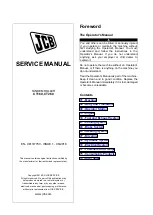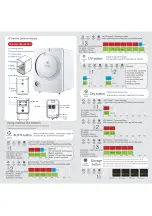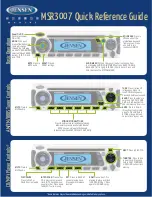
12
INSPECTION
First. stop the machine, see section on stopping.
Caution:
To avoid personal injury wear sturdy gloves as a
precaution.
The wind turbine blades are capable of causing
GRAVE PERSONAL INJURY and should be treated
with the same respect as an aircraft propeller.
Regularly inspect the following :
Hub to shaft nut (priority No. l)
Blade fasteners & nuts
Wind turbine blades
Tail vane screws
Pole mount screws
Brushes
The Pacific Wind Generator should be inspected
regularly, particularly after stormy weather, for signs of
accidental damage. Any minor nicks in the edge of a blade
may be dressed out but the blade must be replaced if there
is any sign of damage or cracking near the root.
Since the blades are supplied as matched, balanced pairs,
any damaged blade must be replaced along with its
opposite number.
The unit may be run with two blades missing, whilst the
replacements are obtained, at reduced performance since
difficulty in starting will be encountered.
NEVER ALLOW THE MACHINE TO RUN OUT OF
BALANCE
The blade material has exceptional fatigue resistance
which is of the utmost importance in hostile locations
such as tropical sunshine and mountain tops.
The material is, however, subject to slow degradation due
to ultra violet light which increases towards the tropics
and with altitude.
This process is slow and when it becomes apparent as a
white powdering of the blade surface, particularly along
leading and trailing edges, the blades may be carefully
painted with two-pack polyurethane after light sanding.
Do not mix up the balanced pairs
.
The shaft seal protecting the front bearing should be
renewed after 2 - 3 years of regular use.
Also the lower bearing and "O" seal. The ball bearings
should be replaced when they become noisy, causing a
once per revolution ‘knock’.
Regularly check the security of the fixings on hub, vane
and pole. If damage to the paint occurs, clean off any
corrosion and repaint. Clean the brushes, taking care not
to damage the brush spring when handling.
MAJOR DISASSEMBLY
a)
Stop the Pacific, see Section on Stopping.
b)
Disconnect from the batteries, removing the fuses first,
see Figures 5 & 6 (Circuit diagrams).
c)
Remove the wind turbine. The centre nut has a left
handed thread and so is rotated clockwise to remove. Pull
the hub away from the machine and give a very careful
tap on the end of the shaft with a rubber faced mallet if
necessary. If difficulty is encountered in removing the hub
from the shaft, avoid hammering on the shaft-end. Ampair
offer a purpose made puller.
d)
Remove the tail vane.
e)
Feed some excess cable length up the pole.
f)
Remove the fastener from the pivot and lift the machine
off the pole.
PIVOT SECTION
With the machine on the bench, undo the two black brush
holder caps and remove the brushes to a safe place.
Prise out the end of the spiral retaining ring from around
the pivot lower bearing. Withdraw the pivot assembly, a
good tug may be needed. Inspect the slip rings, clean if
necessary.
Inspect the lower bearing, if this is loose, obtain a
replacement. Inspect the top bearing in the pivot housing.
Inspect the "O" rings and "V" seal, replace if worn.
It is sometimes easier to remove the Pacific generator
head with the pivot in situ. Disconnect the battery first and
remove the brushes.
Uncoil the retaining ring and lift the body over the pivot.
The exposed slip-ring must be protected from the
environment if the generator is removed for further
servicing.
When reassembling put silicone grease (not petroleum
grease or jelly) around the shaft where it passes through
the lower bearing. Slide the bearing and "V" seal down the
shaft about 20mm and wipe grease around the shaft.
Slide the bearing back up the shaft and remove the excess
grease, wipe a fillet of grease around the point where the
"V" seal sits and slide the "V" seal into place.
Before reinsertion wipe the slip rings to remove any trace
of contamination due to handling and put grease around
the lower bearing "O" ring. Gently slide into place and
wind the spiral retaining ring into its grove.
Clean and replace the brushes. Re-check the pivot for
gram. Secondly, lay the assembled turbine on a flat
surface face down, this will reveal any blade bend as the
tips should be above the surface by an equal amount plus
or minus 3 mm.
Blades will be checked and re-balanced, free of charge, on
request, if returned to the factory.
Any other machine noise should also be investigated.
Only after very extended running life should there be any
detectable bearing noise.
If this is the case, refer to the maintenance section for
instructions on their replacement.
Summary of Contents for Pacific 100
Page 10: ...10 Fig 8 ...
































